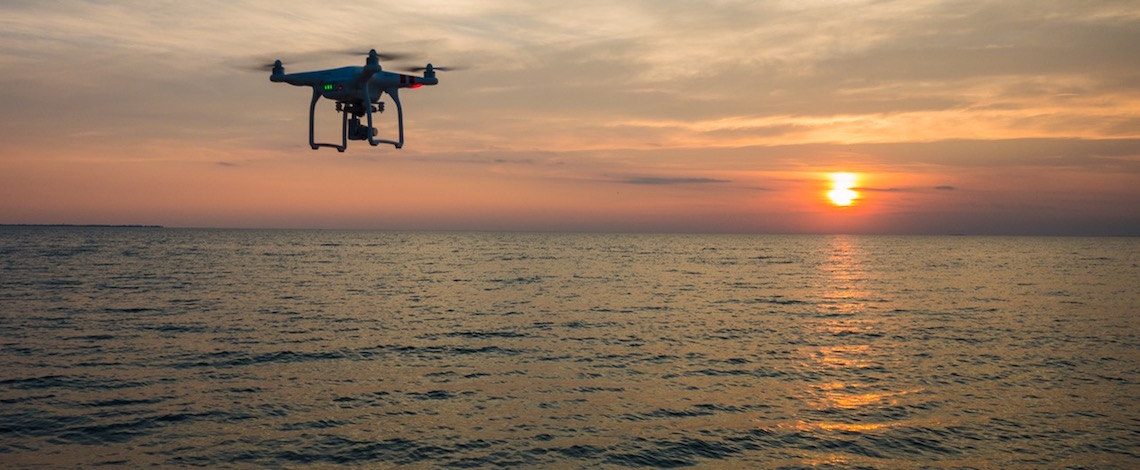
Drone image via pexels.com
New regulations for commercial drones went into effect last August, adding more steps required for media or surveying companies to get off the ground.
But changes by the Federal Aviation Administration haven’t slowed the growing $6-billion industry or caused local film producers to put their aerial shots on the back burner.
In addition to registering their drones with the FAA, pilots must now shell out a few hundred dollars to take a UAV (Unmanned Aircraft Vehicles) pilot’s certification test if they intend to fly for commercial purposes.
Newly clarified restrictions for commercial use tend to be less arduous. Among them, operators are required to fly no higher than 400 feet and no faster than 100 miles an hour. Flying drones at night, over people, near airports and stadiums or out of one’s line of sight is prohibited as well.
However, pilots can now also pay $250 for waivers that allow for activities such as night flying or higher altitude shots.
The restrictions haven’t been that limiting for Enrique Meza of Meza Films in Fresno. With around three years of experience at the controls, Meza said it’s just a matter of flying cautiously — as he’s always done.
“I think you still have a lot of flexibility and are able to catch a lot of good stuff with the basic guidelines,” Meza said. “If you’re filming something and client asks if we can go higher, we just say ‘no, these are the rules.’”
He added that software imbedded into his DJI Inspire drone will pull up warnings if he happens to be lingering too close to a no-fly zone such as an airport.
If liability is a concern, Meza explained that on-demand drone insurance is available from companies such as Verifly to protect against accidents that may occur during a film shoot.
While frustrating for some, the new license requirements are more than worth it for others seeking an edge in aerial photography.
For Blare Media of Fresno, the technology adds dynamics to the company’s commercial projects that wouldn’t be possible to capture any other way, especially when it comes to its work for agriculture operations.
“These are big places with a lot of buildings, forklifts or just a field or orchard,” said filmmaker Justin McAleece. “It’s just a ton of space and trying to cover that would be really hard any other way.”
The media production company has been using drones for nearly seven years in order to film not only commercials, but also corporate videos, music videos and movies.
Its latest projects utilize the Inspire 1 drone’s dual camera controls that has one operator focused on flying while another is free to point at and record objects below. The device’s GPS system is also more accurate and self-correcting than older drones, while the battery offers 20 minutes of flight time when fully charged.
McAleece said he now plans to acquire the newest Inspire 2 drone released a few months ago, complete with two batteries for longer flight time and a camera that shoots in the more editable raw image format.
However, he added that many filmmakers can now get quality footage and maneuverability from smaller, lower-end models like the DJI Mavic, Spark or Phantom drones.
“When it was more of a hobby thing it would cost quite a bit of money. Now you can get a really capable drone for like $600,” he said.
As the price of drones comes down, more filmmakers are getting into the game. Unfortunately, that also means fewer jobs for pilots like Troy Ruff of Ruff Productions in Fresno.
Specializing in advertisements or promotional films for companies, Ruff said it was easier to find work five years ago when only a few film companies in California were good at flying.
“Now that so many people have drones, it’s hard to up the rate and some people don’t want to deal with the risk or equipment,” said Ruff, who started out with his partner building their own single-rotor helicopter to capture shots.
Although the new quadcopters make it easier to hold position, Ruff said the industry is still lacking in experienced pilots that know how to orient the drone and control the camera for smoother shots.
Regardless, Ruff said he may move away from aerial photography over the next few years to focus on making movies.
For those like him, aerial footage hasn’t been a huge selling point anyway. Meza said in any video, you might see two or three shots from a drone, usually to establish a scenery or add perspective.
“It’s not like if you don’t have a drone you’re not going to get a job,” Meza said. ”Let’s focus on telling your company’s story and make it more of a sharable piece instead of focusing on the shot.”
With its updated rules making it easier to become a commercial drone operator, the FAA estimated the number of commercial UAVs to grow from 42,000 at the end of 2016 to about 442,000 aircraft by 2021.
Besides the new certification test replacing a traditional pilot’s license and special case-by-case permission from the regulators, the agency also said it’s working on a new rule that eventually will allow drone flights over people and beyond line of sight.
And following a federal appeals court ruling in May, recreational drone users learned they will no longer have to register their aircraft with the FAA. Refunds of the $5 registration are eligible to those who already did so.
Still, many small aerial photographers and even manufacturers remain irked over costly license requirements and months spent waiting for exemptions to be approved.
“These high barriers to entry have prevented many companies from exploring the benefits of drones in their industry, and have been a source of frustration for business owners for years,” DJI, the world’s biggest commercial drone-maker, explained in a statement last June.








